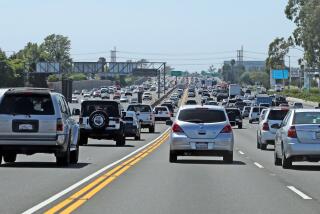The Consumer Goes Bump
- Share via
A U.S. appeals court in Washington has decided that the Reagan Administration acted within its authority in 1982 when it weakened the federal bumper standard on cars. That action, taken by the National Highway Traffic Safety Administration, has already cost owners of late-model cars tens of millions of dollars. Unless Congress legislatively overrides the court decision, consumers are faced with the possibility of paying hundreds of millions more in coming years for needlessly higher auto-insurance premiums and damage-repair costs.
From 1979 to 1982 cars sold in the United States were required to have bumpers able to withstand 5-m.p.h. collisions without significant damage to either the cars or the bumpers themselves. That standard was readily met, and it was a success. Both the frequency of insurance claims and the average loss payment per insured vehicle fell for cars with the 5-m.p.h. bumpers. But the Reagan Administration, as part of its deregulatory push, reduced the crash-resistance standard to only 2.5 m.p.h. The result, an attorney for State Farm Insurance Co. says, has been a “consumer disaster.”
The Administration claimed that a weaker bumper would in fact save consumers money, since it would be cheaper to produce and, being lighter, would lead to better fuel economy. No doubt the weaker bumper was less expensive to make, which is the main reason most auto makers wanted it. But if car manufacturers passed on these savings to consumers it has been a well-kept secret. As for fuel savings, they have been virtually invisible with the flimsier bumpers. In the case of some popular models, increased fuel efficiency because of the lighter bumpers amounts to fewer than 2 gallons a year . Indeed, on some models the weaker bumpers actually added weight to the car.
The numbers get a lot more impressive when it comes to comparing repair costs before and after the change in the bumper rule. For example: The Honda Accord manufactured just before the rule change suffered no damage in a 5-m.p.h. front-end crash test; the Accord one model year later suffered $314 worth of damage in the same test. Similarly with the Plymouth Reliant--no damage with the 5-m.p.h. bumper, $176 in damage with the weaker bumper. What changed? Crash-resistant bumpers have hydraulic devices or materials, like foam, that absorb the energy of a minor impact in low-speed crashes. Cheaper bumpers are mounted with rigid brackets that allow body metal and the bumpers themselves to be crumpled.
Some car makers, notably Ford and Toyota, were smart enough to keep the 5-m.p.h. bumper when the standard was relaxed. Some others, including Honda, have since gone back to it on some or all of their models. But weaker bumpers are still used on a lot of cars, including some of the heaviest and most expensive models, where damage-repair costs from even low-speed collisions are very high. That’s why Congress ought to see to it that the tougher standard is restored. A lot of money is riding on such action, and ultimately all of it will come out of the pocket of every American who owns an automobile.






